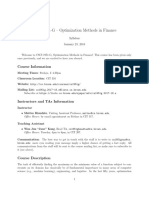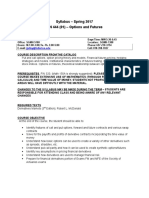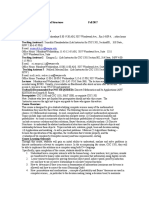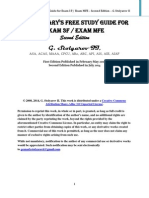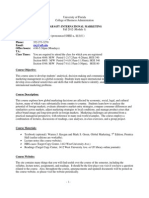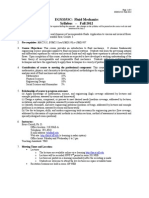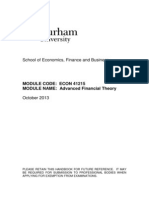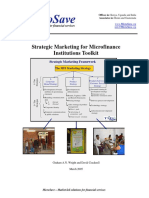New York University Leonard N. Stern School of Business
New York University Leonard N. Stern School of Business
Uploaded by
gauravroongtaCopyright:
Available Formats
New York University Leonard N. Stern School of Business
New York University Leonard N. Stern School of Business
Uploaded by
gauravroongtaOriginal Description:
Original Title
Copyright
Available Formats
Share this document
Did you find this document useful?
Is this content inappropriate?
Copyright:
Available Formats
New York University Leonard N. Stern School of Business
New York University Leonard N. Stern School of Business
Uploaded by
gauravroongtaCopyright:
Available Formats
NEW YORK UNIVERSITY Leonard N.
Stern School of Business
Advanced Futures and Options FINC-GB.3340.01 (B40.3340) Fall 2011 Course Description:
Professor Marti G. Subrahmanyam Teaching Assistant: Jason Levine
This course consists of three parts. The first section of the course is a detailed examination of the pricing and hedging of option contracts, with particular emphasis on the application of these concepts to the design of derivatives instruments and trading strategies. The first part of this section is a review and re-examination of materials covered in the basic course, but with greater rigor and depth of coverage. The emphasis in the second part of this first section is on trading applications and risk management. The second section of the course is designed to provide a broad exposure to the subject of interest rate derivative products, both swaps and options. The last section of the course deals with recent innovations in the derivatives markets such as exotic options, credit derivatives and catastrophe derivatives. In the first section of the course, the discussion of trading strategies is in the context of the management of the risk of a derivatives book. Although the principles developed in this course are relevant to the pricing and hedging of any derivative asset, their applications to the specific cases of options on stocks, stock indices, foreign exchange, futures contracts and interest rate instruments are analyzed. The topics covered in the second part of the course include the relationship of swaps to other fixed income contracts such as futures contracts and forward rate agreements, valuation and hedging of swaps, building the yield curve, and valuation and hedging of interest rate options, with particular reference to caps, floors and swaptions, and modeling the term structure of interest rates. The application of these concepts to foreign exchange and commodity derivatives is also discussed in this section. The third section of the course deals with non-standard option contracts such as exotic options and options on new underlying instruments such as credit, weather and insurance derivatives. Although the discussion of exotic options is fairly broad, some exotic instruments such as barrier options, Asian options and hybrid (correlation) products will be analyzed in more detail. Credit derivatives, with particular reference to credit default swaps and collateralized debt obligations will be the focus of attention in the second part of this section.
The pedagogy is a combination of lectures/discussions and PC-based problem solutions. The course is intensive and requires a fair amount (~ 6-8 hours) of homework each week, in addition to preparation for class. The orientation of the course is the practical application of option concepts, rather than a discussion of option theory by itself. However, since option concepts are somewhat mathematical, a strong quantitative background, though not required, would be an advantage. Required/Recommended Textbooks/Software: Recommended: Optional: J.C. Hull, Options, Futures and other Derivative Securities, 8th edition, Prentice-Hall, 2011. (H) R. Sundaram and S. Das, Derivatives: Principles and Practice, McGrawHill/Irwin, 2011. FINCAD Analytics Suite 2011 for Excel The book by Hull is probably the most comprehensive derivatives textbook available today. We will use it as background, but will not follow it closely. The forthcoming book by Das and Sundaram is more intuitive. Since the book has not yet been published, I will distribute selected chapters of the manuscript. Other Materials: ---Copies of overhead transparencies. [To be handed out in class] Problem sets and computer exercises. [To be handed out in class. Also, available on the course website on Blackboard.] Option pricing/hedging software. [Available on the course website on Blackboard.]
Instructions: Students in the course are expected to study the readings and problem sets prior to the assigned dates and come prepared to discuss them in class. The following outline represents the topics, readings, assignments and dates for discussion. The reference dates noted are rough estimates for the time allotted to each subject area. Any modifications of the schedule will be announced in class.
There are several problem sets roughly one per week throughout the course - to be worked out in groups. In many instances, students are required to use PC-based software for the solution of the problem sets. Students should work on the problem sets in groups of three. No exceptions to this rule will be permitted without the permission of the instructor. Solutions to the problem sets should be worked out, printed and handed in prior to class on the dates they are due. Hand calculators will be necessary for problem sets and examinations. Students are urged to bring calculators to all sessions. The lectures and reading materials assigned will, in many instances, provide an appropriate format for analysis and solution of the problem sets. There will be two take-home quizzes and a final examination in the course. Grading for the course will be based approximately on the following weights: Problem Sets and Assignments Class Participation Quizzes Final Examination 20% 20% 20% 40% --------l00%
The overall grade distribution in the course will be approximately as follows: A AB+ B B C+ C 10-15% 10-15% 15-25% 15-25% 15-25% 10-15% 0% (hopefully)
All class sessions will be videotaped and webcast. However, viewing these recordings is meant to be a supplement and not a substitute for attending class sessions. Based on past experience, much of the learning in the course is from participating in the class discussions.
Classroom Etiquette and Related Matters: Students registered in the course are expected to attend all sessions and be in class by 10.30 am. They should sit in the same place each class, as per the seating chart circulated in the first session. Students who come in late should enter from the side door of the classroom and take their places on the last row, as quietly as possible. Since class participation is assessed and forms part of the grade in the course, regular class attendance is required. In line with school policy, the use of laptop computers, cellular phones and mobile communication devices, and other electronic equipment is not
allowed during class sessions. In order to use the class sessions more efficiently, quizzes are scheduled to be taken at home. It is to be understood that students take quizzes without any external help from others. Any breach of this rule will be taken seriously. Students should adhere to the MBA Honor Code and every student is obligated to report to the instructor any suspected violation of the code that he or she has observed. Further instructions are available at http://w4.stern.nyu.edu/scorp/committee.cfm?doc_id=4797. Students with disabilities are advised to meet the instructor to make arrangements for appropriate help after consulting the Moses Center for Students with Disabilities (CSD, 998-4980. Course Prerequisite: Pricing of Options, Futures and Other Contingent Claims FINC-GB.3335 (B40.3335) Students who have not taken the prerequisite are required to take the permission of the instructor before taking the course. Office Hours: Tuesdays, 12 noon 1 p.m., Thursdays, 12 noon 1 p.m., and by appointment. (Please call Ms. Hakema Zamdin at 998-0301 for an appointment.) In addition, there will also be office hours in an internet chat-room, approximately every other week. Details will be announced in the second week of class. Office: Tutor: Room 9-68, KMC Jason Levine Tel: X80348 Tel: X80314 e-mail:msubrahm@stern.nyu.edu e-mail: jlevine@stern.nyu.edu
COURSE OUTLINE
Date Sess. No. 09/06 I
Subject Introduction and Review * Definition of the Contracts * Payoff Diagrams * Basic Option Trading Strategies * Reverse Engineering of Option Payoffs
Chapter or Source
H, Ch. 1 (review)
H, Ch. 11 (review)
09/08 II
Introduction and Review (Contd.) * No-arbitrage Restrictions * Early Exercise of American Options H, Ch. 10 (to p. 220) H, Ch. 10 (pp. 224-231)
09/13 III
Introduction and Review (Contd.) * Put-Call Parity The Binomial Model * Single-stage Model * Riskless Hedge * Replication H, Ch. 12 (to p. 259) H, Ch. 10 (pp. 221-224)
Problem Sets # 1 and # 2 Payoff Diagrams, Reverse Engineering and No-Arbitrage Restrictions
Date
Sess. No.
Subject The Binomial Model (Contd.) * Risk-Neutral Probability * Multiple Stages * American Options * Dynamic Hedging
Chapter or Source
09/15 IV
H, Ch. 12 (p. 229-273) R. Sundaram
Problem Set #3 Put-Call Parity
09/20 V
The Binomial Model (Contd.) * The Limiting Case * Construction of Binomial Lattices H, Ch. 20
09/22 VI
The Black-Scholes-Merton Model * Intuitive Interpretation of Volatility * Simple Proof of the Model H, Ch.14
Problem Set #4 Binomial Model
Date Sess. No. 09/27 VII
Subject The Black-Scholes-Merton Model (Contd.) * Alternative Proofs (Intuition) * Computational Issues * Extensions: Futures (Black) * Stock Indices, Dividends, Foreign Exchange
Chapter or Source
H, Ch.14
H, Ch.17 H, Ch.16
10/04 VIII
The Black-Scholes Model (Contd.) * Alternative Assumptions * Hedge Ratio * Implied Volatility * Measurement of Volatility * Empirical patterns of volatility: smile, mean-reversion H, Ch.18 (pp. 380-387) M. Brenner/ M. Subrahmanyam (1) H, Ch. 22 (skim)
10/06 IX
Valuation and Hedging of American Options * The Early Exercise Decision * Binomial Method * Trinomial Method * Monte Carlo Method * Finite Difference Method * Geske-Johnson Approximation R.Stapleton/ M. Subrahmanyam (1) H, Ch.20 (pp. 442-466) H, Ch.12 (after p. 263)
Date
Sess. No.
Subject Sensitivity Analysis I (Option Values) * Option Delta * Option Theta, Vega (Kappa)
Chapter or Source
10/11 X
H, Ch.18 (to p. 396)
10/13 XI
Sensitivity Analysis II (Option Hedge Ratios) * Option Gamma * Option Omega H, Ch.18 (after p. 396) Brenner/ Subrahmanyam (2)
Problem Set #5 Sensitivity Analysis: Option Values and Hedge Ratios
10/18 XII
Review Session
10/20 XIII Quiz #1
Date
Sess. No.
Subject Option Position Analysis * Position Delta * Position Gamma * Position Theta * Position Vega Value at Risk * Basic Concepts * Measurement Issues * BIS Requirements
Chapter or Source
10/25 XIV
H, Ch. 21
10/27 XV
Futures and Forward Contracts * Definitions and Basics of Pricing
H, Ch. 2 (review) H, Ch. 3 (skim)
* Over-the-Counter and Exchange-Traded Products * Forward Rate Agreements 11/01 XVI Basics of Interest Rate Swaps and FRA's * Relationship between FRA's and Swaps * Relationship between Swaps and Bonds * Spot - Forward Parity, Pricing of FRA's * Convexity Differences between FRA's and Futures * Adjusting for Convexity H, Ch. 29 (to p. 674) Acharya et al. H, Ch. 7 (to p. 159) R. Stapleton/ M. Subrahmanyam (2)
Date
Sess. No.
Subject
Chapter or Source
Problem Set #6 Position Analysis
11/03 XVII
Pricing, Valuation and Hedging of Swaps * Valuation of Interest Rate Swaps: Principal and Forward Methods H, Ch. 7 * PVBP Analysis and Hedging of a Swap Portfolio *Other Swaps: Currency, Equity, Commodity etc., H, Ch. 32
11/08 XVIII
Building the Yield Curve * Zero Curves versus Forward Curves * Using Money Market Rates and Swap Rates * Interpolation and Bootstrapping Methods
Problem Set #7 FRAs and Swaps
10
Date
Sess. No.
Subject Interest Rate Option Pricing/Hedging
Chapter or Source H, Ch. 28 (to p. 652)
11/10 XIX
* European Options on Bonds and Interest Rates * Option Payoffs and Strategies for Interest Rate Options * Classification of Interest Rate Options Products * No-Arbitrage Relationships: Caplets, Bond Options, Swaptions 11/15 XX Interest Rate Caps and Floors H, Ch. 28 (pp. 653-659)
* Valuation Using the Black-Scholes Model R.Stapleton and M.Subrahmanyam (3) * Valuation Using the Black Model * Hedging With Forwards/Futures Contracts Problem Set #8 Building the Yield Curve
11/17 XXI
Interest Rate Swaptions Valuation Using the Black Model Problem Set #9 Interest Rate Caps/Floors
H, Ch. 28 (after p. 659)
11
Date
Sess. No.
Subject
Chapter or Source
11/29 XXII
Forward/Spot Models of the Term Structure H, Ch. 31 (to p. 694) * Pros And Cons Of Forward Versus Spot Models * Spot Rate Models * Black-Karasinski, Hull-White models * Forward Rate Models: Ho-Lee, Heath-Jarrow-Morton, Libor Market Model (Brace-Garatek-Musiela) H, Ch. 31 (skim) Problem Set # 10 Interest Rate Swaptions
Quiz #2
12/01 XXIII
Exotic Options Features of exotics * Main types * Binomial model of valuation/hedging * Uses of exotic options
H, Ch. 25 (to p. 575)
12
Date
Sess. No.
Subject Barrier options * Knock-out, knock-in options
Chapter or Source H, Ch. 25 (pp. 575-581)
* In-the-money versus out-of-the-money knock-out options * Problems of valuation/hedging
Problem Set # 11 The Ho-Lee Model
12/06 XXIV
Exotic Options (Contd.) Asian options * Effect of averaging: valuation/hedging * General path-dependent structures * Problems of valuation/hedging Hybrid (Correlation) products * Quanto options * Problems of valuation/hedging * Volatility/Variance Swaps * Static options replication
H, Ch. 25 (after p. 561)
13
Problem Set # 12 Barrier Options
12/08 XXV
New Derivative Instruments: Credit * Credit Derivatives: Products * Credit Default Swaps * Collateralized Debt Obligations
H, Ch. 24
Problem Set # 13 Asian Options
12/13 XXVI
New Derivative Instruments: Credit (Contd.) * Credit Derivatives: Pricing H, Ch. 24
Case
Nexgen: Structured Collateralized Debt Obligations (CDOs)
14
12/15 XXVII
Extra session
Review Session
12/20 XXVIII
Final Examination
15
NEW YORK UNIVERSITY Stern School of Business B40.3340 Advanced Futures and Options Professor Marti G. Subrahmanyam Fall 2011
Instructions for the First Three Classes 1. Get course materials [textbook (recommended, not required), case] from the bookstore. 2. Pick up other materials [course package, readings, problem sets] in the first class. 3. Do Problem Sets 1 and 2.
16
DEFAULT POLICIES FOR STERN COURSES-Revised February 2011
The following are policies students should assume are in force in their Stern courses, unless their instructors explicitly establish different policies: Laptops, Cell Phones, Smartphones, Recorders & Other Electronic Devices May not be used in class. Attendance Required and part of grade. Faculty will excuse absences and entertain requests to change exam and assignment due dates only in cases of documented serious illness, family emergency, religious observance, or civic obligation. If you will miss class for religious observance or civic obligation, you must inform your instructor no later than the first week of class. Recruiting activities, business trips, and vacation travel, and club activities are not acceptable reasons for absences or requests to schedule exams and assignments. If a student is absent from the first day of an intensive course, the instructor may request that the student be removed from the course. Arriving Late, Leaving Early, Coming & Going Students are expected to arrive to class on time and stay to the end of the class period. Arriving late or leaving class early will have impact on the course grade. Students may enter class late only if given permission by the instructor and can do so without disrupting the class. (Note that instructors are not obliged to admit late students or readmit students who leave class or may choose to admit them only at specific times.)
17
Late Submission of Assignments Late assignments will either not be accepted or will incur a grade penalty unless due to documented serious illness or family emergency. Instructors will make exceptions to this policy for reasons of religious observance or civic obligation only when the assignment cannot reasonably be completed prior to the due date and the student makes arrangements for late submission with the instructor in advance. Note that the following policies are in force for all Stern classes: General Behavior Students will conduct themselves with respect and professionalism toward faculty, students, and others present in class and will follow the rules laid down by the instructor for classroom behavior. Students who fail to do so may be asked to leave the classroom. (NYU Stern Code of Conduct, Stern policy) Collaboration on Graded Assignments Students may not work together on graded assignment unless the instructor gives express permission. (NYU Stern Code of Conduct) Grading No more than 35% of students will receive grades of A or A- in MBA core courses. (Stern policy) MBA students who do not submit Course Faculty Evaluations by the deadline will not have access to their final grades until the grade release date, which is determined by program. Faculty are requested not to release final grades to students who fail to submit evaluations and students should not ask. (Stern policy) Recording Classes At any time, your classes may be recorded for educational purposes. (Stern policy) Endorsed by: MBA Core Course Committee, July 9, 2007 Vice Deans, July 13, 2007 Academic Programs & Teaching Resources Committee of Faculty Council, August 1, 2007 Revision approved by Core Course Committee and program Vice Deans, February, 2011
18
NEW YORK UNIVERSITY Leonard N. Stern School of Business
Advanced Futures and Options FINC-GB.3340.01 (B40.3340) Fall 2011
Professor Marti G. Subrahmanyam Teaching Assistant: Jason Levine
Some interesting websites on derivatives There are several websites that offer useful information on derivatives securities and markets. Listed below are some important sites that would be of interest to any student in this area. 1. www.optionmetrics.com This website has a rich dataset and real-time data on US and some European and Asian equity derivatives. (More detailed historical data are also available to the Stern community in a separate database.) It was put together by one of my former Ph.D. students and is used by many of the major industry players in the area of equity derivatives. 2. www.msci.com/products/risk_management_analytics/riskmanager/demos.html This website is a good source of data and research materials on derivatives and risk management. It was spun off by JP Morgan many years ago and was a pioneer in the area of tools and techniques of risk management. It is now part of MSCI. It continues to be a useful source of data and concepts on many aspects of risk management. 3. www.bis.org This is the official website of the Bank for International Settlements (BIS). This organization is the central bankers bank and has been the coordinator for many of the important recent regulatory initiatives of the worlds central banks, which regulate financial institutions and markets around the world. They compile and publish several databases on the global derivatives industry. 4. www.isda.org This is the website of the International Swaps and Derivatives Association, the trade body for the over-the-counter derivatives market, which handles a substantial proportion of all traded derivatives. It has a wealth of information on various aspects of derivatives
markets including the details of the standard contracts for many of these products in the areas of interest rates, foreign exchange, commodities, credit etc. 5. www.cme.com This is the website of the only major US exchange that trades futures and options contracts on a wide range of underlying assets from equities to interest rates to weather. It provides contract details and real-time quotations on most of the major contracts that are traded on exchanges, other than options on individual stocks. 6. www.cboe.com www.globalderivatives.nyx.com/en/trading www.iseoptions.com These are the official websites of the three major US exchanges for equity and stock index options. They provide a plethora of information on individual option contracts, although www.optionmetrics.com consolidates all this information in a more "userfriendly" format. The second of these is the NYSE Euronext platform, which links to several European and US derivatives markets. 7. www.riskcenter.com/ This is an interesting website containing links to various interesting articles, news items and reports on various aspects of derivatives contracts and markets. 8. www.risk.net/ This is the website of Risk magazine, the leading industry publication in the area of derivatives. This magazine has news about the business, recent trends in the industry and a few technical articles on concepts and models that are of interest to practitioners. This is a great resource for anyone involved with the derivatives industry.
9. www.moodys.com www.standardandpoors.com www.fitchratings.com These are the websites of the three major credit rating agencies. They present information about the criteria for ratings as well as the ratings for several issues. The sites contain a mass of statistics about credit risk at the macro and micro levels.
10. www.dtcc.com www.markit.com These two websites relate to OTC derivatives. The Depository Trust and Clearing Corporation is one of the several new OTC clearing houses established in recent years. Markit is a leading data vendor, providing a ranging of pricing services for derivatives. 11. www.cftc.gov/LawRegulation/DoddFrankAct/index.htm http://www.sec.gov/spotlight/dodd-frank.shtml These are the links to the Commodities and Futures Trading Commissions and Securities and Exchange Commission pages on the Dodd-Frank bill, the comprehensive bill on regulation of financial instruments, markets and institutions, passed in July 2010. It also provides information on the progress towards the implementation of the bill, which will affect virtually every major company in the US, particularly those in the financial services industry.
NEW YORK UNIVERSITY Leonard N. Stern School of Business
Advanced Futures and Options FINC-GB.3340.01 (B40.3340) Fall 2011
Professor Marti G. Subrahmanyam Teaching Assistant: Jason Levine
Some interesting websites for derivatives quotes and risk metrics As may be expected, there are several websites that offer useful information on the prices of derivatives securities. While real-time information from sources such as Bloomberg and Reuters would be more comprehensive, there are several websites that offer quotes on the major derivatives markets. Some important examples for the US markets are listed below: Stock Option quotes, Greeks and implied volatilities http://www.888options.com/quotes/default.jsp?ReferredBy=SEM_Goo_0490_A_30&gcl id=CL6HztjiwY4CFRqsOAodi3bMxA http://www.ivolatility.com/options.j http://finance.yahoo.com Eurodollar and Fed Funds Futures quotes http://www.cme.com/trading/dta/del/delayed_quote.html?ProductSymbol=ED&ProductF oiType=FUT&ProductVenue=G&ProductType=itr Swap and Libor quotes http://b2b.thefinancials.com/us_interest_rates.asp Credit Derivative Index quotes http://www.markit.com/markit.jsp?jsppage=indices.jsp
You might also like
- Orange County Value at Risk Case - PPT by SAaD Bin Mehmood IM Sciences PeshawarDocument34 pagesOrange County Value at Risk Case - PPT by SAaD Bin Mehmood IM Sciences PeshawarSaad Bin Mehmood57% (7)
- Course Outline FINA 320 WINTER 2022Document6 pagesCourse Outline FINA 320 WINTER 2022ChrisNo ratings yet
- FIN 301 SyllabusDocument9 pagesFIN 301 SyllabusAnh NguyenNo ratings yet
- Practice Questions - Eqty1Document17 pagesPractice Questions - Eqty1gauravroongtaNo ratings yet
- Practice Questions - Eqty2Document20 pagesPractice Questions - Eqty2gauravroongta67% (3)
- RM FinalDocument19 pagesRM FinalMonir HossainNo ratings yet
- ADawliah Saudi ArabiaDocument435 pagesADawliah Saudi ArabiaDataGroup Retailer AnalysisNo ratings yet
- Market Size: Cost Margin Profit Coracle Other Chemicals TotalDocument2 pagesMarket Size: Cost Margin Profit Coracle Other Chemicals Totalkiketts100% (1)
- Capital Markets & Investments (Lochstoer) SU2014Document5 pagesCapital Markets & Investments (Lochstoer) SU2014darwin12No ratings yet
- 1401 b403388 MaggioriDocument6 pages1401 b403388 Maggioriduchelucia20No ratings yet
- Outline 906Document5 pagesOutline 906麦麦庆达No ratings yet
- Updated FIN812 Capital Budgeting - 2015 - SpringDocument6 pagesUpdated FIN812 Capital Budgeting - 2015 - Springnguyen_tridung2No ratings yet
- BUS 331 01 Syllabus Wynter Spring 2023Document6 pagesBUS 331 01 Syllabus Wynter Spring 2023Javan OdephNo ratings yet
- 1903-ub50-amihudDocument4 pages1903-ub50-amihudThai AnhNo ratings yet
- Syllabus - Quantitative Finance and Economics by Professor Herzog - Fall Term 2013Document7 pagesSyllabus - Quantitative Finance and Economics by Professor Herzog - Fall Term 2013methewthomsonNo ratings yet
- Lomeli M329F F20 WebDocument5 pagesLomeli M329F F20 WebRohan xDNo ratings yet
- Syllabus_ECO271_Fall2021Document4 pagesSyllabus_ECO271_Fall2021mahnumomar11No ratings yet
- Cases and Readings in Corporate FinanceDocument9 pagesCases and Readings in Corporate FinanceAbdillah FaizNo ratings yet
- SyllabusDocument3 pagesSyllabusHenry LiuNo ratings yet
- Fixed Income and Derivative AnalysisDocument5 pagesFixed Income and Derivative AnalysisDaood AbdullahNo ratings yet
- Syl Lab Us 35130Document11 pagesSyl Lab Us 35130Sameer KumarNo ratings yet
- Term IV Course OutlineDocument81 pagesTerm IV Course OutlineAshima shafiqNo ratings yet
- Course Outline Iapm-Prof.p.saravananDocument6 pagesCourse Outline Iapm-Prof.p.saravananNicholas DavisNo ratings yet
- Course OutlineDocument8 pagesCourse OutlinealyssacharlesNo ratings yet
- Syllabus OkDocument4 pagesSyllabus Okproduct.yaqincenterNo ratings yet
- FIN 444 Spring 2017 (Evening) SyllabusDocument4 pagesFIN 444 Spring 2017 (Evening) Syllabus04071990No ratings yet
- FINA 4319 Syllabus Spring 2021-NDocument6 pagesFINA 4319 Syllabus Spring 2021-NAnh NguyenNo ratings yet
- Ec1723 Syllabus Sept4 2018-1Document11 pagesEc1723 Syllabus Sept4 2018-1auctmetuNo ratings yet
- 1500 Goel f17Document4 pages1500 Goel f17ssavage03No ratings yet
- Syllabus FBE555 Fall2017-1Document8 pagesSyllabus FBE555 Fall2017-1Akash GuptaNo ratings yet
- Stolyarov MFE Study GuideDocument279 pagesStolyarov MFE Study GuideChamu ChiwaraNo ratings yet
- B6301 Foundations of Valuation Syllabus Spring 2023 Supera PDFDocument5 pagesB6301 Foundations of Valuation Syllabus Spring 2023 Supera PDFTrialNo ratings yet
- Syllabus FINA210 Business Finance FALL 2013Document6 pagesSyllabus FINA210 Business Finance FALL 2013Mahmoud KambrisNo ratings yet
- MAR6157 International Marketing All Xie, JDocument9 pagesMAR6157 International Marketing All Xie, JMithilesh SinghNo ratings yet
- Chicago SyllabusDocument10 pagesChicago SyllabusOingo BoingoNo ratings yet
- Out 2005Document8 pagesOut 2005w4termel0n33No ratings yet
- MBAA 518 Online Syllabus 0515Document6 pagesMBAA 518 Online Syllabus 0515HeatherNo ratings yet
- 14 310x Data Analysis For Social ScientistsDocument7 pages14 310x Data Analysis For Social ScientistsGorki FreireNo ratings yet
- Kelkhal@usi - Edu: Edition, by Jeff MaduraDocument4 pagesKelkhal@usi - Edu: Edition, by Jeff MaduraTalib DoaNo ratings yet
- MBA 707 51 Financial Management8Document9 pagesMBA 707 51 Financial Management8Sitara QadirNo ratings yet
- RiskDocument4 pagesRiskUtkarsh ChoudharyNo ratings yet
- MGMT 2020 Fall 11fDocument7 pagesMGMT 2020 Fall 11fYunasis AesongNo ratings yet
- FIN101 SyllabusDocument4 pagesFIN101 SyllabusRyan FarellNo ratings yet
- OPR320 SyllabusDocument5 pagesOPR320 Syllabusmoney1000000No ratings yet
- Weaver - Daniel 3339032001spring2020Document7 pagesWeaver - Daniel 3339032001spring2020jNo ratings yet
- PaulCallister Document Assembly Revised Syllabus S2019Document5 pagesPaulCallister Document Assembly Revised Syllabus S2019zokilexNo ratings yet
- CS306 Syllabus Spring 2015 - GMUDocument3 pagesCS306 Syllabus Spring 2015 - GMUMadeline55No ratings yet
- Course Outline - MicroeconomicsDocument5 pagesCourse Outline - MicroeconomicsSha KhNo ratings yet
- FIN3131 FIN3717 S2 2020 2021 Andrew LimDocument5 pagesFIN3131 FIN3717 S2 2020 2021 Andrew Limlutherevanjaya12No ratings yet
- Corporate Finance-Syllabus 2024Document5 pagesCorporate Finance-Syllabus 2024oouescoNo ratings yet
- Managerial Economics (Siconolfi) FA2015Document4 pagesManagerial Economics (Siconolfi) FA2015darwin12100% (1)
- Fina-4332 001Document7 pagesFina-4332 001Kiều Thảo AnhNo ratings yet
- Syllabus BoothDocument6 pagesSyllabus BoothAshish MakraniNo ratings yet
- USC EngecoaDocument5 pagesUSC EngecoaKen RualloNo ratings yet
- Fnce2170001Document7 pagesFnce2170001dakec42763No ratings yet
- #0 - Syllabus FIN823 Derivatives KEWEI HOUDocument5 pages#0 - Syllabus FIN823 Derivatives KEWEI HOUJinsoo YangNo ratings yet
- RM 392.1 Financial Modeling and Optimization (Lasdon) PDFDocument5 pagesRM 392.1 Financial Modeling and Optimization (Lasdon) PDFBeatriz MontoyaNo ratings yet
- EGN3353C Syllabus Fall 2012 UFDocument4 pagesEGN3353C Syllabus Fall 2012 UFtasjaxbchNo ratings yet
- Contracts I Syll Subsections C and DDocument10 pagesContracts I Syll Subsections C and DEmmanuel ByarmNo ratings yet
- PGPM-19-20-T7-FRA-Prof. Tushar JaruharDocument8 pagesPGPM-19-20-T7-FRA-Prof. Tushar JaruharSiddharth GuptaNo ratings yet
- Institute of Business Administration Course Outline Financial DerivativesDocument4 pagesInstitute of Business Administration Course Outline Financial Derivativessushant_vjti17No ratings yet
- UT Dallas Syllabus For Fin6360.001.08f Taught by Nataliya Polkovnichenko (nxp063000)Document6 pagesUT Dallas Syllabus For Fin6360.001.08f Taught by Nataliya Polkovnichenko (nxp063000)UT Dallas Provost's Technology GroupNo ratings yet
- Financial Modeling Syllabus Spring 2015Document5 pagesFinancial Modeling Syllabus Spring 2015Siddhartha ThakurNo ratings yet
- School of Economics, Finance and Business: Module Code: Econ 41215 MODULE NAME: Advanced Financial TheoryDocument8 pagesSchool of Economics, Finance and Business: Module Code: Econ 41215 MODULE NAME: Advanced Financial TheoryalexgideiNo ratings yet
- BienvenuShaferShen PDFDocument40 pagesBienvenuShaferShen PDFgauravroongtaNo ratings yet
- Chapter 8 Solution PDFDocument11 pagesChapter 8 Solution PDFgauravroongtaNo ratings yet
- Brochure SP en PDFDocument59 pagesBrochure SP en PDFgauravroongtaNo ratings yet
- Book DraftDocument404 pagesBook DraftgauravroongtaNo ratings yet
- Chapter 6 Solution PDFDocument7 pagesChapter 6 Solution PDFgauravroongtaNo ratings yet
- Chapter 11 SolutionDocument6 pagesChapter 11 SolutiongauravroongtaNo ratings yet
- Statistics For Financial Engineering: Some R Examples: David RuppertDocument60 pagesStatistics For Financial Engineering: Some R Examples: David RuppertgauravroongtaNo ratings yet
- Case BooksDocument1 pageCase BooksgauravroongtaNo ratings yet
- Stochastic Process by J Medhi PDFDocument2 pagesStochastic Process by J Medhi PDFgauravroongta0% (2)
- Balloon Payment Loan Calculator: InputsDocument4 pagesBalloon Payment Loan Calculator: InputsgauravroongtaNo ratings yet
- Banks With TaglinesDocument5 pagesBanks With TaglinesRavi Romeo100% (1)
- CFA Level 2 Fixed Income 2017Document52 pagesCFA Level 2 Fixed Income 2017EdmundSiauNo ratings yet
- Complete List of Indian Banks and Their Heads - CMDs - CEOs - Gr8AmbitionZ PDFDocument8 pagesComplete List of Indian Banks and Their Heads - CMDs - CEOs - Gr8AmbitionZ PDFNageswara ReddyNo ratings yet
- Bank Branch Management Retail BankingDocument5 pagesBank Branch Management Retail Bankingrgovindan123No ratings yet
- FT FRM Study PlanDocument11 pagesFT FRM Study PlanTrinh DucNo ratings yet
- Philippine Interpretations Committee (Pic) Questions and Answers (Q&As)Document6 pagesPhilippine Interpretations Committee (Pic) Questions and Answers (Q&As)verycooling100% (1)
- Financial Derivatives LPDocument6 pagesFinancial Derivatives LPRama Prasanth0% (1)
- Amrapali Aadya PresentationDocument22 pagesAmrapali Aadya Presentationjhansi ki raniNo ratings yet
- Technical AnalysisDocument16 pagesTechnical AnalysisVipin Prabhakar Singh100% (1)
- Customer Satisfaction On Demat AccountDocument92 pagesCustomer Satisfaction On Demat Accountmohammad tanveerNo ratings yet
- ICICI 7P'sDocument15 pagesICICI 7P'sdheeraj422No ratings yet
- Strategic Marketing For Mfis Toolkit 938Document98 pagesStrategic Marketing For Mfis Toolkit 938Saurabh KadamNo ratings yet
- Sales PromotionDocument26 pagesSales PromotionPriyanka JaraliNo ratings yet
- EFB344 Lecture10, Options 3Document30 pagesEFB344 Lecture10, Options 3Tibet LoveNo ratings yet
- Thomas Cook ReportDocument21 pagesThomas Cook ReportVignesh Karthick Ramamoorthy100% (1)
- Chapter 1Document43 pagesChapter 1Saket BhobooNo ratings yet
- 360 DegreeDocument1 page360 DegreeMuhammad FaizanNo ratings yet
- Sapm Unit 2 Part 1Document43 pagesSapm Unit 2 Part 1Sushma KumarNo ratings yet
- Integrated Marketing CommunicationDocument58 pagesIntegrated Marketing Communicationkatherine magraciaNo ratings yet
- Volatility: Markets Markets, Which Move Quickly, Are High Volatility MarketsDocument4 pagesVolatility: Markets Markets, Which Move Quickly, Are High Volatility MarketspetefaderNo ratings yet
- Problem Set Solutions v3Document3 pagesProblem Set Solutions v3Bockarie LansanaNo ratings yet
- Hedging Foreign Exchange RiskDocument5 pagesHedging Foreign Exchange RiskKarthik ChandrashekarNo ratings yet
- 04 Review 280613Document6 pages04 Review 280613ajayvmehtaNo ratings yet
- Session-Costing and PricingDocument16 pagesSession-Costing and PricingDivyanshJainNo ratings yet
- Effect of Basel III On Indian BanksDocument52 pagesEffect of Basel III On Indian BanksSargam Mehta50% (2)
- Chapter 7: International Banking and Money MarketDocument2 pagesChapter 7: International Banking and Money MarketVeeranjaneyulu KacherlaNo ratings yet
























